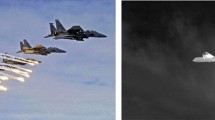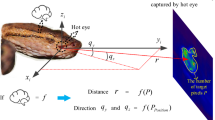Abstract
The bottleneck of artificial interference in the background of complex air combat is the major obstacle in the precise detection and guidance of infrared air-to-air missiles. Occlusion and similarity of infrared point-source interference to aerial targets pose a serious challenge to the anti-interference tracking performance of an infrared imaging seeker. Based on the analysis of relative motion of the target and interference and the spatial topological structure of multi-object in the image plane, we propose an anti-interference tracking algorithm based on the spatiotemporal correlation of an image plane topological graph network. Through infrared image preprocessing and connected-region labeling, the regions of the image plane are automatically and accurately extracted to achieve accurate detection of suspected targets. The topological graph network of the image plane multi-objects is established by using the geometric topological relation of the connected regions, spatial direction relation, and spatial distance relation. Using the anti-interference tracking strategy of the spatiotemporal correlation of the topological graph network, the topological graph of the current frame is registered according to its spatial topological relationship; further, automatic acquisition of the target under a strong interference situation is realized. The optimization of the parameters effectively solves the problem of searching and matching suspected target nodes in the graph alignment. One-pass evaluation experiments show high tracking accuracy and speed of 90.0% and 248.6 FPS, respectively.










Similar content being viewed by others
References
O. Akin, E. Erdem, A. Erdem, K. Mikolajczyk, Deformable part-based tracking by coupled global and local correlation filters. J. Vis. Commun. Image Represent. 38, 763–774 (2016). https://doi.org/10.1016/j.jvcir.2016.04.018
A.C. Berg, T.L. Berg, J. Malik, Shape matching and object recognition using low distortion correspondences, in Proceedings of 2005 IEEE Computer Society Conference on Computer Vision and Pattern Recognition, vol. 1 , (2005) pp. 26–33
L. Bertinetto, J. Valmadre, S. Golodetz, O. Miksik, P.H.S. Torr, Staple: Complementary learners for real-time tracking, in 2016 IEEE Conference on Computer Vision and Pattern Recognition (CVPR) (2016) pp. 1401–1409 . https://doi.org/10.1109/Cvpr.2016.156
C. Cortes, V. Vapnik, Support-vector networks. Mach. Learn. 20, 273–297 (1995). https://doi.org/10.1023/A:1022627411411
M. Danelljan, G. Hager, F.S. Khan, M. Felsberg, Discriminative scale space tracking. IEEE Trans. Pattern Anal. Mach. Intell. 39, 1561–1575 (2017). https://doi.org/10.1109/tpami.2016.2609928
J. Gu, V. Tresp, Interpretable graph capsule networks for object recognition. (2020). arXiv:2012.01674
K.I. Kim, M.O. Franz, B. Scholkopf, Iterative kernel principal component analysis for image modeling. IEEE Trans. Pattern Anal. Mach. Intell. 27, 1351–1366 (2005)
M. Leordeanu, R. Sukthankar, Thoughts on a recursive classifier graph: a multiclass network for deep object recognition (2014). arXiv:1404.2903
S. Li, K. Yang, J. Ma, X. Tian, X. Yang, Anti-interference recognition method of aerial infrared targets based on the Bayesian network. J. Opt. 50, 264–277 (2021). https://doi.org/10.1007/s12596-021-00701-2
Y. Li, J. Zhu, S.C.H. Hoi, Reliable patch trackers: Robust visual tracking by exploiting reliable patches, in 2015 IEEE Conference on Computer Vision and Pattern Recognition (CVPR) (2015) pp. 353–361
D. Liang, S. Gao, H. Sun, N. Liu, UAV detection in motion cameras combining kernelized correlation filters and deep learning. Acta Aeronaut. Astronaut. Sin. 41, 323733 (2020)
L. Lin, X. Wang, Y. Wei, J.H. Lai, Discriminatively trained and-or graph models for object shape detection. IEEE Trans. Pattern Anal. Mach. Intell. 37, 959–972 (2015)
F. Liu, H. Wang, G. Huang, L. Lu, X. Wang, UAV target tracking algorithm based on adaptive depth network. Acta Aeronaut. Astronaut. Sin. 40, 174–183 (2019)
C. Ma, X.K. Yang, C.Y.Y. Zhang, M.H. Yang, Long-term correlation tracking, in 2015 IEEE Conference on Computer Vision and Pattern Recognition (2015) pp. 5388–5396
G. Marsiglia, L. Fortunato, A. Ondini, G. Balzarotti, Template matching techniques for automatic IR target recognition in real and simulated scenarios: tests and evaluations, in Automatic Target Recognition Xiii, vol. 5094, (2003) pp. 159–169 . https://doi.org/10.1117/12.486065
M. Mueller, N. Smith, B. Ghanem, Context-aware correlation filter tracking, in 30th IEEE Conference on Computer Vision and Pattern Recognition (CVPR) (2017) pp. 1387–1395. https://doi.org/10.1109/Cvpr.2017.152
C. Ning, W.B. Liu, X. Wang, Infrared object recognition based on monogenic features and multiple kernel learning, in 2018 IEEE 3rd International Conference on Image, Vision and Computing (ICIVC) (2018) pp. 204–208
J. Revaud, G. Lavoue, Y. Ariki, A. Baskurt, Learning an efficient and robust graph matching procedure for specific object recognition, in Proceedings of International Conference on Pattern Recognition (2010) pp. 754–757 . https://doi.org/10.1109/ICPR.2010.190
S. Ullman, Object recognition and segmentation by a fragment-based hierarchy. Trends Cognit. Sci. 11, 58–64 (2007). https://doi.org/10.1016/j.tics.2006.11.009
V. Vapnik, R. Izmailov, Rethinking statistical learning theory: learning using statistical invariants. Mach. Learn. 108, 381–423 (2019). https://doi.org/10.1007/s10994-018-5742-0
V.N. Vapnik, Complete statistical theory of learning. Autom. Remote Control 80, 1949–1975 (2019). https://doi.org/10.1134/S000511791911002x
N. Wang, W. Zhou, Q. Tian, R. Hong, M. Wang, H. Li, Multi-cue correlation filters for robust visual tracking, in 2018 IEEE/CVF Conference on Computer Vision and Pattern Recognition (CVPR) (2018) pp. 4844–4853. https://doi.org/10.1109/CVPR.2018.00509
I. Weiss, Robust model-based object recognition using a dual-hierarchy graph, in Automatic Target Recognition Xxii, ed. by F.A. Sadjadi, A. Mahalanobis (2012). https://doi.org/10.1117/12.920167
I. Weiss, A dual-hierarchy semantic graph for robust object recognition (2019). arXiv:1909.06867
Z. Xu, L. Wu, Z. Wang, R. Wang, Z. Li, F. Li, Matching UAV images with image topology skeleton, in 2013 IEEE International Geoscience and Remote Sensing Symposium (IGARSS) (2013) pp. 546–549. https://doi.org/10.1109/IGARSS.2013.6721214
J. Zhang, M. Marszalek, S. Lazebnik, C. Schmid, Local features and kernels for classification of texture and object categories: a comprehensive study. Int. J. Comput. Vis. 73, 213–238 (2007). https://doi.org/10.1007/s11263-006-9794-4
W. Zhang, X.J. Wang, A prototype selection method for synthetic object recognition based on structural graph model. Appl. Mech. Mater. 713–715, 2063–2068 (2015)
D. Zhang, J. Zhang, K. Yao, M. Cheng, Y. Wu, Infrared ship-target recognition based on SVM classification. Hongwai Jiguang Gongcheng Infrared Laser Eng. (2016). https://doi.org/10.3788/IRLA201645.0104004
Acknowledgements
This work was supported in part by the National Natural Science Foundation of China (62273279, 61703337) and Aviation Science Foundation of China (ASFC-20191053002).
Author information
Authors and Affiliations
Corresponding author
Additional information
Publisher's Note
Springer Nature remains neutral with regard to jurisdictional claims in published maps and institutional affiliations.
Rights and permissions
Springer Nature or its licensor (e.g. a society or other partner) holds exclusive rights to this article under a publishing agreement with the author(s) or other rightsholder(s); author self-archiving of the accepted manuscript version of this article is solely governed by the terms of such publishing agreement and applicable law.
About this article
Cite this article
Yang, X., Li, S., Zhang, X. et al. Anti-interference aerial target tracking for infrared seeker via spatiotemporal correlation of topological graph networks. J Opt 52, 510–519 (2023). https://doi.org/10.1007/s12596-022-01038-0
Received:
Accepted:
Published:
Issue Date:
DOI: https://doi.org/10.1007/s12596-022-01038-0




